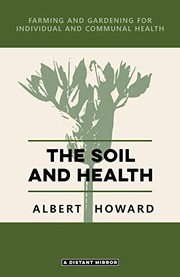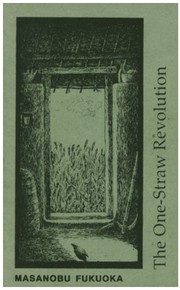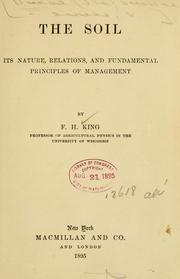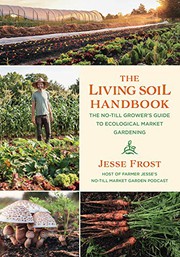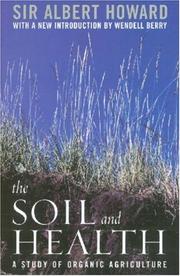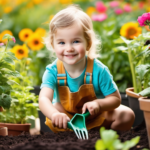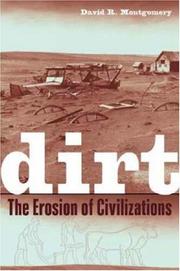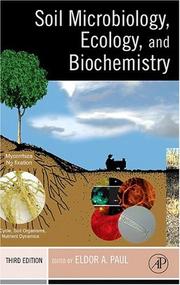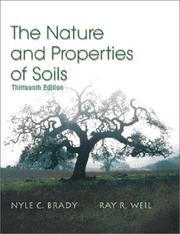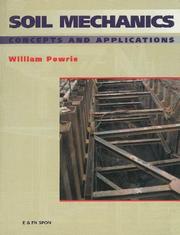Are you passionate about gardening, agriculture, or environmental science? Then you’ll love diving into the world of soil with these 20 best books about soil. Whether you’re a farmer looking to improve your soil health, a student studying soil science, or just a curious reader eager to learn more about this essential resource, there’s a book on soil for everyone. From comprehensive guides to practical handbooks, these soil books offer valuable insights into the fascinating world beneath our feet. Get ready to dig in and explore the amazing diversity and importance of soil with these top picks!
Contents
- 1 20 Best Soil Books
- 2 Dirt to Soil
- 3 The Hidden Half of Nature
- 4 Growing a Revolution
- 5 Teaming with Microbes
- 6 The Soil and Health
- 7 The One-Straw Revolution
- 8 The Soil: Its Nature, Relations, and Fundamental Principles of Management
- 9 The Living Soil Handbook
- 10 The Soil and the Microbe
- 11 The Soil and Health: A Study of Organic Agriculture
- 12 The Hidden Life of Trees
- 13 Teaming with Microbes: The Organic Gardener’s Guide to the Soil Food Web
- 14 Dirt: The Erosion of Civilizations
- 15 The Hidden Half of Nature: The Microbial Roots of Life and Health
- 16 Soil Microbiology, Ecology, and Biochemistry
- 17 The One-Straw Revolution: An Introduction to Natural Farming
- 18 The Nature and Properties of Soils
- 19 Soil Mechanics: Concepts and Applications
- 20 The Soil Will Save Us
- 21 The Soil: A Portrait of Rural Life in Meiji Japan
- 22 Final Thoughts on Best Soil Books
- 23
20 Best Soil Books
Dirt to Soil
by Gabe Brown
Dirt to Soil by Gabe Brown is a transformative book on soil that takes readers on a journey from conventional farming practices to regenerative agriculture. With captivating storytelling, Brown shares his personal experiences and the lessons he has learned about building healthy, resilient soil. Through his innovative approach, Brown demonstrates how to restore degraded land, increase biodiversity, and improve overall farm productivity. This book about soil is a must-read for anyone interested in sustainable agriculture, as it offers practical insights and actionable strategies for regenerating our precious earth. Whether you’re a farmer, gardener, or simply a lover of the land, Dirt to Soil will inspire you to rethink the way we interact with the natural world. With its wealth of knowledge and compelling narrative, this soil book is a valuable resource for anyone seeking to better understand and care for the foundation of our food system.
The Hidden Half of Nature
by David R. Montgomery and Anne Biklé
The Hidden Half of Nature by David R. Montgomery and Anne Biklé is a captivating exploration of the intricate relationship between microbes and plants in the world beneath our feet. This eye-opening book on soil takes readers on a journey through the hidden world of soil, revealing the crucial role that microbes play in the health of our planet. Through the authors’ engaging storytelling and insightful research, readers will gain a new appreciation for the complex and interconnected web of life within the soil.
Montgomery and Biklé’s book about soil not only delves into the science of microbiology, but also offers a fresh perspective on the potential impact of soil health on human health. By uncovering the hidden half of nature, the authors shed light on the importance of nurturing and preserving the delicate balance of microbes and plants in the soil. This thought-provoking and informative soil book is a must-read for anyone interested in understanding the vital role that soil plays in sustaining life on Earth.
Growing a Revolution
by David R. Montgomery
David R. Montgomery’s Growing a Revolution is a captivating exploration of the power of regenerative agriculture in revitalizing our depleted earth. The book delves into the author’s global journey to uncover the potential of soil regeneration in combating environmental degradation and fostering sustainable food production. Through engaging storytelling and insightful research, Montgomery highlights the transformative impact of regenerative farming practices, demonstrating how they can improve soil health, increase crop yields, and mitigate climate change.
With a compelling blend of scientific analysis and real-world examples, Growing a Revolution offers a thought-provoking narrative that inspires readers to reconsider their relationship with the land. Montgomery’s passion for the subject shines through as he advocates for a shift towards regenerative agriculture, making this book a must-read for anyone interested in the future of farming and the environment. Whether you’re a seasoned farmer or simply curious about the potential of soil regeneration, this book about soil promises to inform, inspire, and ignite a passion for nurturing the earth.
Teaming with Microbes
by Jeff Lowenfels and Wayne Lewis
Teaming with Microbes by Jeff Lowenfels and Wayne Lewis is a fascinating book about the hidden world beneath our feet. This groundbreaking book on soil reveals the intricate relationships between plants, microbes, and fungi that make up the soil food web. Lowenfels and Lewis take readers on a journey into the complex and interconnected ecosystem of the soil, showing how these tiny organisms play a crucial role in the health and vitality of our plants and planet.
Through engaging storytelling and accessible language, the authors explain the symbiotic relationships between plants and the microbial life in the soil, offering practical tips for gardeners and farmers to harness the power of the soil food web. Whether you’re a seasoned gardener or just starting out, this soil book is a must-read for anyone looking to deepen their understanding of the natural world and cultivate a thriving, sustainable garden or farm.
The Soil and Health
by Albert Howard
The Soil and Health by Albert Howard is a groundbreaking book on soil, written by a pioneer in the field of organic agriculture. This influential work explores the connections between soil fertility, food quality, and human health, emphasizing the importance of nurturing the soil as a living ecosystem. Howard’s insights into the symbiotic relationship between soil microorganisms, plants, and animals have had a profound impact on modern sustainable farming practices. In this book about soil, Howard challenges conventional agricultural methods and offers a compelling vision for a regenerative approach to land management. With its blend of scientific rigor and practical wisdom, The Soil and Health is a must-read for anyone interested in understanding the vital role that healthy soil plays in sustaining life on earth. Whether you’re a seasoned farmer, a passionate gardener, or simply curious about the wonders of the natural world, this soil book will leave you inspired to cultivate a deeper connection with the land.
The One-Straw Revolution
by Masanobu Fukuoka
The One-Straw Revolution by Masanobu Fukuoka is a groundbreaking book on soil that challenges conventional agricultural practices. Fukuoka, a Japanese farmer and philosopher, advocates for a natural farming approach that requires minimal intervention. His revolutionary method focuses on the principles of no-till, no-chemicals, and no-pesticides, emphasizing the importance of working in harmony with nature. Through his insightful observations and practical techniques, Fukuoka demonstrates how a deep understanding of the soil and its ecosystem can lead to sustainable and abundant harvests. His philosophy encourages a shift from the prevalent industrialized agriculture towards a more holistic and ecological approach to farming. The One-Straw Revolution is not just a book about soil, but a profound manifesto that inspires readers to rethink their relationship with the land and explore alternative ways of nurturing the earth. Fukuoka’s wisdom and vision continue to resonate with farmers, environmentalists, and anyone interested in the interconnectedness of life and the soil.
The Soil: Its Nature, Relations, and Fundamental Principles of Management
by F.H. King
The Soil: Its Nature, Relations, and Fundamental Principles of Management by F.H. King is a comprehensive book about soil and its management. King delves into the nature of the earth’s surface, the composition of soil, and its fundamental principles of management. The book provides a deep understanding of the importance of soil and its relation to agriculture, ecology, and the environment. King’s authoritative and engaging writing style makes this book a must-read for anyone interested in understanding the complexities and significance of soil. Whether you are a farmer, a gardener, an environmentalist, or simply curious about the ground beneath your feet, this book offers valuable insights into the role of soil in sustaining life on our planet. The Soil: Its Nature, Relations, and Fundamental Principles of Management is a timeless and indispensable resource for anyone seeking to deepen their knowledge of this vital natural resource.
The Living Soil Handbook
by Jesse Frost
The Living Soil Handbook by Jesse Frost is a comprehensive and practical guide to understanding and nurturing the earth beneath our feet. This book about soil explores the intricate and diverse world of soil and its vital role in sustaining life. Through engaging and accessible language, Frost delves into the science of soil, explaining its composition, structure, and the countless organisms that call it home.
Readers will learn how to improve and maintain soil health, with valuable insights on composting, cover cropping, and organic farming practices. Frost also discusses the crucial connection between healthy soil and the food we eat, making a compelling case for sustainable agricultural methods.
Whether you’re a seasoned farmer, a passionate gardener, or simply curious about the world beneath your feet, The Living Soil Handbook is an essential resource for anyone seeking a deeper understanding of this vital resource. With practical tips and a wealth of knowledge, this book on soil is sure to inspire a newfound appreciation for the living ecosystem beneath us.
The Soil and the Microbe
by Selman A. Waksman
The Soil and the Microbe by Selman A. Waksman is a groundbreaking book on soil and its intricate relationship with microbes. Waksman, a renowned microbiologist and Nobel Prize winner, delves deep into the complex world beneath our feet, exploring the vital role that microbes play in the health and fertility of soil. Through his engaging and accessible writing, Waksman uncovers the fascinating interactions between soil and the countless microorganisms that inhabit it, from bacteria to fungi to protozoa.
This book about soil is a must-read for anyone interested in understanding the critical role that microbes play in the natural world, as well as those seeking to improve agricultural practices and environmental sustainability. The Soil and the Microbe offers a comprehensive and enlightening look at the often overlooked world beneath our feet, and Waksman’s expertise and passion for the subject shine through in every page. Whether you’re a scientist, a farmer, or simply a curious reader, this soil book will open your eyes to the wonders of the microbial world in the soil.
The Soil and Health: A Study of Organic Agriculture
by Sir Albert Howard
The Soil and Health: A Study of Organic Agriculture by Sir Albert Howard is a groundbreaking book on soil and agriculture that explores the intricate relationship between soil and human health. Howard, a pioneer in the field of organic farming, delves into the importance of cultivating and maintaining healthy soils for the production of nutritious food and the overall well-being of ecosystems.
This book about soil emphasizes the significance of organic methods in preserving the vitality of the earth, advocating for a more sustainable and regenerative approach to agriculture. Howard’s insights into soil fertility, composting, and the interconnectedness of plant, animal, and human health are as relevant today as they were when the book was first published in 1947.
Whether you’re an avid gardener, a farmer, or simply interested in the vital role that soil plays in our lives, this soil book is a must-read for anyone seeking a deeper understanding of the fundamental relationship between soil and health.
The Hidden Life of Trees
by Peter Wohlleben
The Hidden Life of Trees by Peter Wohlleben is a captivating and enlightening book about the intricate and fascinating world of forests. Wohlleben, a forester, shares his deep understanding of the interconnectedness of trees and the secrets of their hidden lives. Through vivid storytelling and scientific insights, he reveals how trees communicate, cooperate, and care for each other in a complex social network underground. This book delves into the rich and diverse ecosystem of the forest, exploring the symbiotic relationships between trees, fungi, and other organisms that make up the ‘book on soil’ beneath our feet. Wohlleben’s passion for the natural world shines through as he uncovers the astonishing ways in which trees support each other and the vital role they play in maintaining the health of the ‘soil’ and the environment. Whether you’re a nature enthusiast or simply curious about the wonders of the natural world, The Hidden Life of Trees offers a thought-provoking journey into the heart of the forest.
Teaming with Microbes: The Organic Gardener’s Guide to the Soil Food Web
by Jeff Lowenfels, Wayne Lewis
Teaming with Microbes is a fascinating book on soil that delves into the intricate world beneath our feet. Authors Jeff Lowenfels and Wayne Lewis offer an insightful look into the soil food web, exploring the complex relationships between microorganisms, plants, and the environment.
This book about soil provides a comprehensive guide for organic gardeners, offering valuable insights into the importance of nurturing a healthy soil ecosystem. Lowenfels and Lewis explain how understanding and working with the soil food web can lead to improved plant health, increased yields, and a more sustainable approach to gardening.
Whether you’re a seasoned gardener or just starting out, Teaming with Microbes is a must-read for anyone looking to deepen their understanding of the soil beneath their feet. The book’s engaging and accessible style makes it an invaluable resource for anyone interested in cultivating a thriving and biodiverse garden.
Dirt: The Erosion of Civilizations
by David R. Montgomery
Dirt: The Erosion of Civilizations by David R. Montgomery is a captivating exploration of the impact of soil erosion on human history. This eye-opening book delves into the crucial role that soil plays in the rise and fall of civilizations, and how soil degradation has contributed to the collapse of societies throughout history. Montgomery skillfully weaves together geology, archaeology, and anthropology to illustrate the profound connection between soil health and the fate of human societies.
Through engaging storytelling and thought-provoking analysis, Montgomery sheds light on the importance of sustainable land use and the devastating consequences of neglecting the health of our land. Dirt: The Erosion of Civilizations is a compelling and timely read that offers valuable insights into the long-term effects of soil erosion on human societies. Whether you’re a history enthusiast, environmentalist, or simply curious about the impact of soil on civilization, this book is a must-read.
The Hidden Half of Nature: The Microbial Roots of Life and Health
by David R. Montgomery, Anne Biklé
The Hidden Half of Nature is a captivating exploration of the intricate relationship between humans, plants, and the microbial world beneath our feet. Written by David R. Montgomery and Anne Biklé, this groundbreaking book on soil uncovers the vital role that microbes play in shaping the health of our environment, as well as our own bodies.
Through engaging storytelling and scientific research, the authors reveal how the health of the soil, often overlooked and undervalued, directly impacts human health. They delve into the fascinating world of soil microbes, showing how these tiny organisms are essential for nutrient cycling, disease suppression, and even our own immune systems.
Montgomery and Biklé’s exploration of the hidden half of nature offers a new perspective on the interconnectedness of all living things, and the profound implications for agriculture, medicine, and environmental sustainability. This eye-opening book about soil is a must-read for anyone interested in the natural world and the unseen forces that shape our lives.
Soil Microbiology, Ecology, and Biochemistry
by Eldor A. Paul
Soil Microbiology, Ecology, and Biochemistry by Eldor A. Paul is an in-depth exploration of the fascinating world beneath our feet. This comprehensive book about soil delves into the complex interactions between microorganisms, plants, and the environment, providing a thorough understanding of the biological and biochemical processes that shape the soil ecosystem.
Paul’s writing is engaging and accessible, making the complex concepts of soil microbiology and ecology understandable for readers of all levels. From the roles of bacteria and fungi in nutrient cycling to the impact of human activities on soil health, this soil book covers a wide range of topics with clarity and insight.
Whether you’re a student, researcher, or soil enthusiast, this book on soil is a valuable resource for gaining a deeper appreciation of the intricate web of life beneath our feet. With its detailed explanations and real-world examples, Soil Microbiology, Ecology, and Biochemistry is a must-read for anyone eager to explore the hidden world of soil.
The One-Straw Revolution: An Introduction to Natural Farming
by Masanobu Fukuoka
The One-Straw Revolution: An Introduction to Natural Farming by Masanobu Fukuoka is a groundbreaking book about soil that challenges traditional agricultural practices. Fukuoka, a Japanese farmer and philosopher, advocates for a natural and minimalist approach to farming, which he calls “do-nothing” farming. He proposes that by working in harmony with nature, farmers can achieve higher yields and healthier crops without the use of chemical fertilizers, pesticides, or tilling.
Through his personal experiences and observations, Fukuoka shares his innovative techniques for growing rice, vegetables, and fruit trees that require minimal human intervention. He emphasizes the importance of nurturing the soil and harnessing the power of natural processes to create a self-sustaining and resilient ecosystem.
The One-Straw Revolution is a thought-provoking and inspiring read for anyone interested in sustainable agriculture, permaculture, or ecological farming. Fukuoka’s profound insights and practical wisdom offer a refreshing perspective on the potential of working in harmony with nature to cultivate healthy and abundant harvests.
The Nature and Properties of Soils
by Ray R. Weil, Nyle C. Brady
The Nature and Properties of Soils is a comprehensive and engaging book on soil written by Ray R. Weil and Nyle C. Brady. This authoritative resource provides a thorough overview of the science of soil, covering topics such as soil formation, classification, and physical, chemical, and biological properties. The book also delves into the role of soil in the environment, agriculture, and natural ecosystems.
Readers will gain a deep understanding of the intricate world beneath our feet, as the authors explore the complex interactions between soil, water, air, and living organisms. With its clear explanations and informative illustrations, this soil book is suitable for students, educators, and professionals in the fields of agriculture, environmental science, and natural resource management. Whether you are a soil science enthusiast or just curious about the fascinating world of soil, The Nature and Properties of Soils is a must-read for anyone interested in learning more about this essential natural resource.
Soil Mechanics: Concepts and Applications
by William Powrie
Soil Mechanics: Concepts and Applications by William Powrie is a comprehensive and insightful book on soil that delves into the fundamental concepts and practical applications of soil mechanics. The book provides a thorough understanding of the behavior of soils and their engineering applications, making it an essential resource for students and professionals in the field of civil and geotechnical engineering.
Readers will gain a deep understanding of topics such as soil classification, soil compaction, stress distribution in soil, and the principles of soil stabilization. Powrie’s clear and engaging writing style makes complex concepts accessible, while the inclusion of real-world examples and case studies enhances the practical relevance of the material.
Whether you are a student looking to grasp the essentials of soil mechanics or a practicing engineer seeking to deepen your knowledge, this book about soil is an invaluable resource. With its blend of theoretical insights and practical applications, Soil Mechanics: Concepts and Applications is a must-have for anyone working with soils in an engineering context.
The Soil Will Save Us
by Kristin Ohlson
The Soil Will Save Us by Kristin Ohlson is a fascinating exploration of the power and potential of the earth beneath our feet. This captivating book delves into the world of regenerative agriculture and the remarkable ability of soil to sequester carbon and combat climate change. Ohlson takes readers on a journey through diverse landscapes and introduces them to innovative farmers, scientists, and ranchers who are revolutionizing the way we think about soil. Through compelling storytelling and insightful research, The Soil Will Save Us makes a compelling case for the vital role that healthy soil plays in sustaining life on our planet. This eye-opening book about soil is a must-read for anyone interested in environmental sustainability, agriculture, and the future of our planet. The Soil Will Save Us is a thought-provoking and hopeful exploration of the incredible potential of soil to heal our planet and create a more sustainable future for generations to come.
The Soil: A Portrait of Rural Life in Meiji Japan
by Kazuko Tsurumi
The Soil: A Portrait of Rural Life in Meiji Japan by Kazuko Tsurumi is a captivating and insightful exploration of the agricultural landscape and the lives of rural farmers in Meiji Japan. This book offers a rich and detailed portrayal of the interconnectedness between the people and the land, delving into the intricacies of rural life, traditional farming practices, and the profound significance of the soil in shaping the cultural and social fabric of the time.
Through meticulous research and evocative storytelling, Tsurumi brings to life the experiences of the farmers, their struggles, triumphs, and the enduring bond they share with the earth. The Soil is a compelling and thought-provoking read that sheds light on the profound impact of the land on the lives of the people who toil upon it, offering a glimpse into a world where the soil is not just a physical entity, but a spiritual and cultural force that shapes the very essence of rural existence.
Final Thoughts on Best Soil Books
In conclusion, these 20 books about Soil offer a comprehensive and insightful exploration of the fascinating world beneath our feet. Whether you’re a gardener, environmentalist, or simply curious about the earth’s dynamic ecosystem, these books provide valuable knowledge and inspiration. From practical gardening tips to in-depth scientific research, there’s something for everyone to learn and appreciate about the vital role soil plays in our world. Dive into one of these books and unearth the wonders of soil today!
Which book about Soil is best?
The best book on Soil can vary with personal preference, but three widely recommended titles are:
- Dirt to Soil by Gabe Brown,
- The Hidden Half of Nature by David R. Montgomery and Anne Biklé,
- Growing a Revolution by David R. Montgomery.
Each offers valuable insights and could be a great starting point.
What are the best books to learn about Soil?
For those looking to learn about Soil, there is a wealth of literature that can provide a comprehensive understanding of the subject. Some of the most highly recommended books include:
- Dirt to Soil by Gabe Brown,
- The Hidden Half of Nature by David R. Montgomery and Anne Biklé,
- Growing a Revolution by David R. Montgomery,
- Teaming with Microbes by Jeff Lowenfels and Wayne Lewis,
- The Soil and Health by Albert Howard,
- The One-Straw Revolution by Masanobu Fukuoka,
- The Soil: Its Nature, Relations, and Fundamental Principles of Management by F.H. King,
- The Living Soil Handbook by Jesse Frost,
- The Soil and the Microbe by Selman A. Waksman,
- The Soil and Health: A Study of Organic Agriculture by Sir Albert Howard
These books offer a range of perspectives on Soil, covering various aspects and approaches to the subject.
What are the best books about Soil?
The best books about Soil are:
- Dirt to Soil by Gabe Brown,
- The Hidden Half of Nature by David R. Montgomery and Anne Biklé,
- The Hidden Life of Trees by Peter Wohlleben,
- Teaming with Microbes: The Organic Gardener’s Guide to the Soil Food Web by Jeff Lowenfels, Wayne Lewis,
- The Living Soil Handbook by Jesse Frost,
- The One-Straw Revolution by Masanobu Fukuoka.
Each offers unique insights into the subject. While these books about Soil are highly regarded, it’s important to note that any list of ‘best’ books is subjective and reflects a range of opinions.
What are the best Soil books of all time?
Choosing the best Soil books of all time can vary depending on who you ask, but five titles that are often celebrated include
- Dirt to Soil by Gabe Brown,
- The Hidden Half of Nature by David R. Montgomery and Anne Biklé,
- The Soil and Health by Albert Howard,
- The Living Soil Handbook by Jesse Frost,
- and The Hidden Life of Trees by Peter Wohlleben.
Each of these books has made a significant impact in the field of Soil and continues to be influential today.





